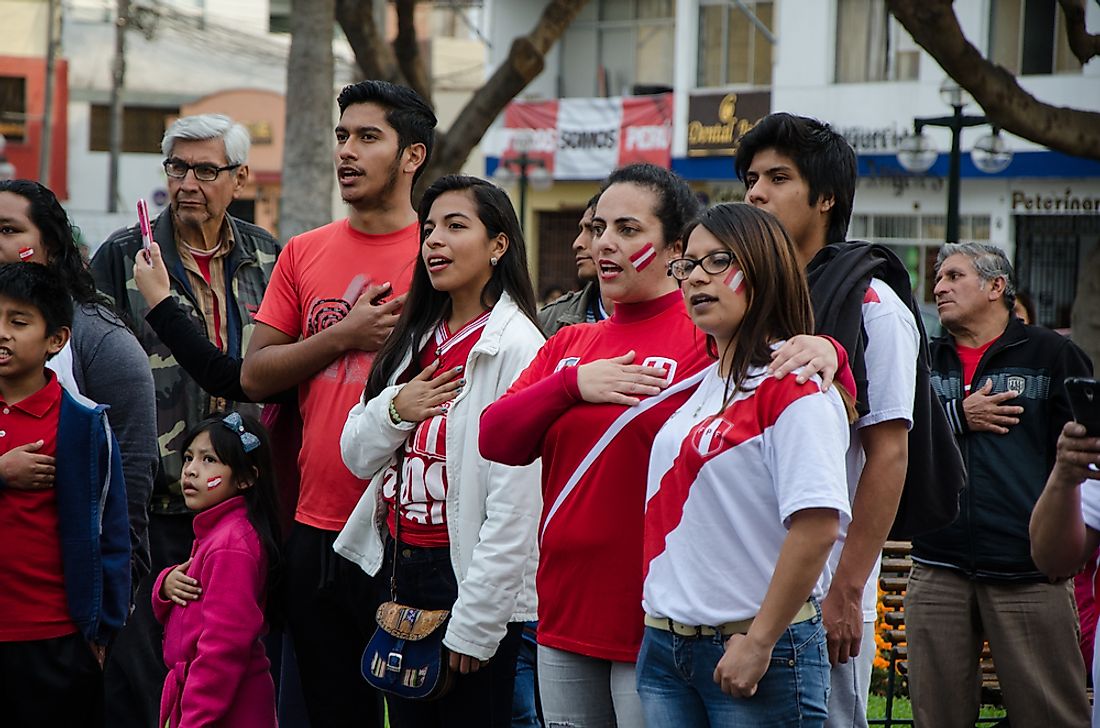The Peruvian People - Cultures around the World

5. Description
As a multiethnic country located in western South America, Peru is comprised by indigenous ethnicities as well as multiple foreign groups, the latter of which have inhabited the country for the past five centuries. Before Spanish conquistadors colonized the country in the 16th Century, Peru was exclusively home to the Amerindians, its indigenous people, for several millennia (with some estimates dating back to as far as 6,000 BC). Today, Amerindians constitute about 30 per cent of Peru’s demography. During the Spanish Colonial period, large numbers of Spaniards and Africans entered the country. After Peru became an independent nation in 1821, it saw a progressive increase in immigration of European people, especially from Spain and Italy, and to a lesser extent from France, Germany, the Balkans, and Great Britain. Towards the end of the 19th Century, significant numbers of Chinese and Japanese also entered the country form across the Pacific Ocean. Spanish (or more specifically, Peruvian Spanish) is spoken as a first language by about 84 per cent of the Peruvian population. Several indigenous languages, however, are still in use today. The most prominent among these is Quechua, which is spoken by about 13 percent of the population today. As a result of the assimilation of various ethnicities within the country, “Peruvian” as a term is used referred to refer to a nationality rather than an ethnicity, similar to the term "American" in the United States.
4. Architecture
Peru’s architecture has a long history, dating back to the period of Ancient Peru of about 14,000 years ago, and spanning the Inca Empire (AD 1130-1530), the Spanish conquest of the Inca Empire and colonization (1532-1821), and the era of a home-ruled republican Peru (1821-Present). One way of examining the long and strained history between Amerindians and Conquistadors is through the architecture of the colonial period. During this period, the Spanish Conquistadors, in their want of nurturing their relationship with the Amerindians, built churches, as Christianity was viewed as the most important form of prospective communication between the two communities. As a result, several churches with exquisite façades and interiors were erected. Notable among them is Cusco Cathedral (whose construction took about 65 years, beginning in 1559 and completing in 1654) and Santa Clara Church (Iglesia y Convento de Santa Clara). The Baroque influences of the 16th century can be seen in the construction of the Monastery of San Francisco (Convento de San Francisco), and the façade of the National University of Saint Anthony the Abbot in Cuzco (Universidad Nacional de San Antonio Abad del Cusco). More recently, one notable example of the 20th Century Peruvian architecture is exhibited at the Plaza San Martín (completed in 1921), a public space located in the Peruvian capital city of Lima.
3. Cuisine
The Peruvian cuisine is noted for its long and multicultural history. It is seen as an example of "fusion cuisine". due to it being an amalgamation of the area's traditional cuisine with the fare brought by the immigrants from Europe, West Africa, and Asia. Corn, potatoes and legumes are some of the most important traditional staples of Peruvian cuisine. The Spanish conquistadors brought rice, wheat and European meats, namely beef, pork and chicken. Traditional foods, such as Quinoa ("Amerindian rice") and chili peppers saw resurgence in the culinary interests of the locals. Ceviche, a seafood dish made from fresh raw fish immersed in citrus juices, and then spiced with chili peppers, is a famous dish popular all over Latin America. The dish has its origin in Peru, and is in fact a national dish of the country.
2. Cultural Significance
Perhaps the greatest and most notable landmark of Peruvian culture is that of Machu Picchu. This extant 15th Century Inca site is located 7,970 feet above sea level. Machu Picchu (Spanish for “Old Mountain”) is listed among one of the New Seven Wonders of the World, and is also a UNESCO World Heritage Site. The site long remained unknown to the Spanish colonists, as it was abandoned by the Incas and rediscovered several centuries later. It is Peru’s most visited tourist attraction site, and as a result generates considerable revenue for the Peruvian Government. In the world of sport, the Peruvian National Football (soccer) Team has long been a force within the world scene, and the country's musicians have long been noted for their proficiency, especially the stringed instrument and woodwind players.
1. Threats
Even though the Amerindian population decreased during the Spanish inquisition (from 5-6 million to 600,000) due to infectious diseases and outright killings, today they comprise over 30 per cent of the Peruvian population. The relationship between the Hispanics and Amerindians remains stable. Even though Peru has seen economic growth, totaling 30 percent over recent years, poverty in the country remains a stubborn problem. Many poor children have reportedly dropped out of educational programs (either temporarily or permanently) in order to support their families. The last few decades has not seen any significant immigration to the country, even though Peru has historically been a country of immigrants. In the recent decades, more than 2 million Peruvians have instead emigrated, chiefly into the United States, Spain, and Argentina, and largely due to economic incentives.







